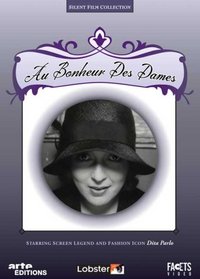| Actors: Dita Parlo, Nadia Sibirskaia, Pierre de Guingand Director: Julien Duvivier Genres: Indie & Art House, Classics, Drama Sub-Genres: Indie & Art House, Silent Films, Love & Romance Studio: ARTE Format: DVD - Black and White,Full Screen DVD Release Date: 04/28/2009 Original Release Date: 01/01/1930 Theatrical Release Date: 01/01/1930 Release Year: 2009 Run Time: 1hr 29min Screens: Black and White,Full Screen Number of Discs: 1 SwapaDVD Credits: 1 Total Copies: 0 Members Wishing: 0 MPAA Rating: NR (Not Rated) Languages: French |
Search - Au Bonheur des Dames on DVD
  | Au Bonheur des Dames Actors: Dita Parlo, Nadia Sibirskaia, Pierre de Guingand Director: Julien Duvivier Genres: Indie & Art House, Classics, Drama NR 2009 1hr 29min The legendary silent screen goddess Dita Parlo (L Atalante; Grand Illusion), whose exotic look and glamorous mystique inspired Madonna, stars as Denise, an orphan girl who comes to Paris to work in her uncle s small shop. ... more » |
Larger Image |
Movie DetailsSimilar Movies
|
Movie ReviewsThe Crème-de-la-Crème of French Silent Films! Barbara (Burkowsky) Underwood | Manly, NSW Australia | 04/14/2010 (5 out of 5 stars) "It was with surprise and great delight that I watched this superb example of the silent film, being made at the very end of the silent era when the art of the silent film had reached its artistic and creative peak. From the opening scenes of busy Paris streets and rushing crowds I immediately knew what style of movie I would enjoy for the remaining 90 minutes. Although a French production, "Au Bonheur des Dames" has elements of German Expressionism and Soviet Avant Garde, with excellent use of lighting and shadows, dynamically changing rhythms of editing and action to create mood and atmosphere, and a solid story with a message to boot. Although it cannot quite be compared to great French silent films like "La Roue", nor a classic of German Expressionism, for a 90-minute film "Au Bonheur des Dames" really packs a punch as it combines the best of silent cinema's artistic qualities, using superimposed images, unusual camera angles, moving camera which smoothly glides through the sets, and mesmerizing sequences of powerful images to convey a message. That message is: what price for progress? A poor family struggles to keep their business in the shadow of the looming grand department store called "Au Bonheur des Dames" - which translates into English as "Ladies' Paradise" - while the owner plans ever bigger expansions of his business enterprise. In the middle of it all is Denise, the main character, played by German actress, Dita Parlo, whose European beauty and style suit this film perfectly. A big star in Germany and also in French films mainly in the 1930s, it is said that pop-star Madonna, among others, was inspired by Dita many decades later. Torn between loyalty to her family and a romance with the boss of the giant department store - referred to as `the Temple of Temptation', this film shows both sides of a battle that no one can truly win without a price to pay. Inspired by a novel by Emile Zola, this film captures the heartache and despair of one family, while showing the `nouveau riches' and the fast-growing consumerism, along with greed and competition. After a dramatic climax, both cast and audience sadly accept that the `future is built on ruins' of the previous generations. The highly acclaimed French director, Julien Duvivier, interpreted this story with its message in a visual medium that has been all but lost since the advent of sound.
Just as the images are dynamic and revolutionary, the accompanying music also strives to attain new levels of musical expression, with some modern, even experimental sounds on various instruments, including voice a few times, but always complementing the movie. There is a short documentary in the bonus material about the making of the music, as well as an introduction to the film, and also a short 1930 French documentary entitled "Le Ventre d'un Magazin" showing the cafeteria of a giant department store where food is prepared daily for its 9,000 staff. It is fun to watch, and goes well with the images in "Au Bonheur des Dames" of the lavish and luxurious real-life department store where many scenes were filmed. Overall, this is a very high quality silent film combining certain styles, and is considered to be one of director Julien Duvivier's finest works. " |



